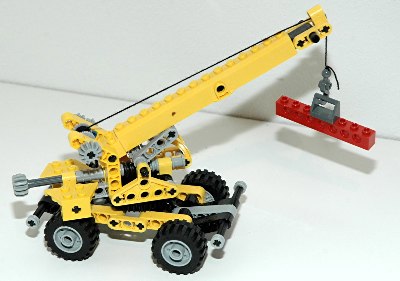New Treads
The original chain links and related treads had been in use
since 1979. This year a new system of much larger treads was
released. Whereas the old treads mated with standard gears, the
new treads use a custom small or large sprocket. Note that the old
treads remained in production for smaller models.
Miscellaneous Parts
A new 8L axle with an integrated stop was released. With the new
Power Functions system, it was important that powered axle be retained
so they wouldn't migrate out over time. The retainer can be
trapped between parts, locking the axle in place.
A new corner pin connector was also released which made stronger corner joints possible.
Power Functions
The new Power Functions system included a wide range of components:
- Motors
- M-motor: The medium motor features a 3L diameter and a 6L
length. There are 4 pin holes on the front and a female 2x6 plate
on the bottom for a variety of attachment options.
- XL-motor: The extra large motor features a 5L diameter and
a 6L length. It has many pin holes on the front and sides, but no
studded attachment options. This motor has the torque to destroy a
Technic axle if stalled.
- Both motors use internal planetary gearing and therefore have
low output speed with relatively high torque. The fact that the
motors were named medium and extra large left an obvious hole for a
potential small and/or large motor.
- Power System
- The new battery box holds 6AA batteries for a total of 9V (or
less if rechargeable batteries are used). It has an integral
current limiter set at about 1A. The battery box can only be
attached studlessly with pin holes. A 3 position switch on the top
of the battery box is used to change polarity.
- The new wiring system includes 4 conductors instead of 2.
Two of these are full time power and ground. The other two, C1 and
C2, are used for control and switching functions. The wires are
much larger and stiffer than the old wires and therefore harder to route
through small spaces.
- A new type of connector (shown in dark gray) was needed
to support the new 4-conductor wiring. Unlike the older connector,
it can only be attached one way and cannot be rotated to change
polarity. The connectors can be stacked to attach components in
parallel.
- Another type of new connector (shown in light gray) is
available only on extension wires. The bottom of this connector
interfaces with the old 9V system. This allows old 9V motors to be
used with the new system, or old battery boxes to use with the new
motors. However, the new remote controllers cannot be used with
old battery boxes because they are powered by the 2 wires that are not
present in the old system.
- Remote Control System
- An infrared receiver was introduced with 2 outputs and 4
channels. Infrared has limited range and does not work well in
direct sunlight, but is much less regulated than radio frequency.
The receiver output allow the control of 2 motors. The protocol is
capable of using Pulse Width Modulation to vary the speed of the motors
in 6 steps in each direction, but this functionality has never been
used in a Technic model. A channel selector (orange switch) on the
receiver can be set in one of four positions, allowing a maximum of 4
receivers and 8 functions to be used at one time without interference.
- An infrared transmitter was introduced with two levers and a
four position channel selector. The switches are momentary (must
be held to maintain command) and allow only 3 options: forward, back, or
off. Each output channel has a polarity reversing switch.
The transmitter uses 3AAA batteries.
- The Power Functions system also includes a train controller
which has speed control output and persistent commands (lever doesn't
need to be held to maintain command), but this has never appeared in a
Technic set.
|
|









